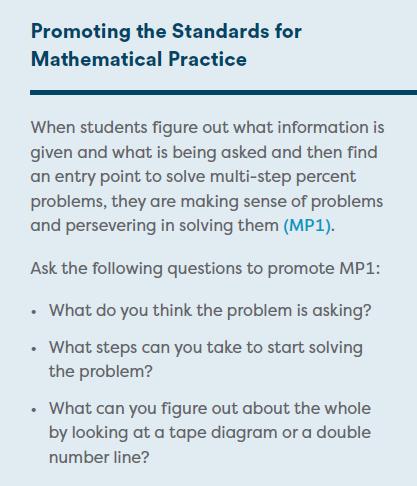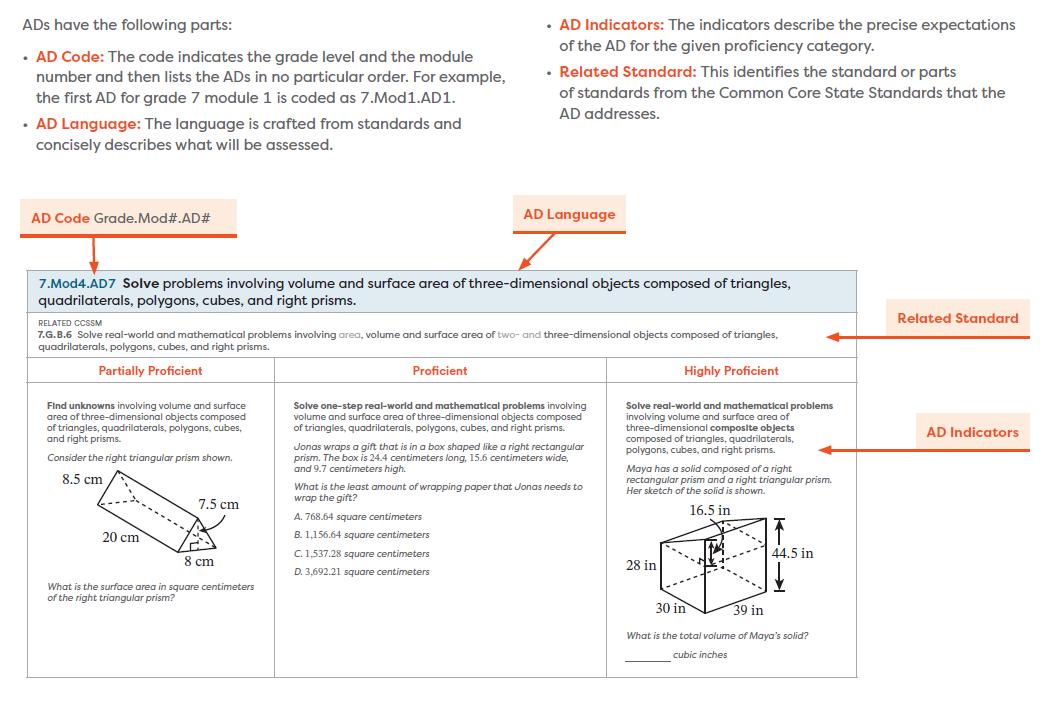
9 minute read
Balance of Rigor
3. Balance of Rigor
A. Curricular materials contain a balance of conceptual understanding, procedural skills and fluency, as well as application of math knowledge.
✓ Eureka Math2 balances the three elements of rigorous mathematics education: conceptual understanding, procedural skill and fluency, and application to real-world contexts. Lessons provide experiences to expand, develop, apply, and practice conceptual understanding, as well as hone procedural and problem-solving skills through joyful fluency exercises and engaging real-world applications.
The curriculum sometimes presents the three elements separately but also often combines them, reinforcing the development of students as flexible thinkers on the path to proficiency. Eureka Math2 addresses these areas with equal intensity, recognizing that all are vital parts of a coherent, effective curriculum.
• The Fluency and Practice components provides daily opportunities for students to practice concepts and procedural skills. Mixed practice is provided twice per module.
• Activities in Launch and Learn generally include a mix of the three elements of rigorous mathematics education. However, Launch often provides an application opportunity for students to engage in some contextual reasoning and problem solving.
• Each segment of Learn, the instructional component of the lesson, often focuses on developing conceptual understanding and is structured to move students from simple problems to more complex problems.
• Land provides an opportunity to consolidate student understanding and reflect on their learning through discussion, and it highlights the
Key Questions of the lesson.
All three elements of rigor are also present in the Practice problems and assessments. For example, in the Algebra 1 module 2 lesson 3 Practice, students are given a set of linear graphs and are asked to write an equation that represents the line (procedural skill and fluency), several word problems (application), and an opportunity to explain their thinking (conceptual understanding).
the robust knowledge base that underpins the structure and content framework. See Selection of Eureka Math2 Research Citations in Appendix B.

B. Curricular materials support the development of students’ conceptual understanding with i. simple–to–complex problem sequences, and ii. concrete–pictorial–symbolic
✓ Eureka Math2 develops students’ conceptual understanding in several critical ways, emphasizing deep knowledge building and ensuring that students understand the “why” rather than just the “how” of math. Concepts progress coherently within and across modules and levels so students build on what they already know. Lessons invite students to engage and respond with a variety of representations: visual, symbolic, verbal, contextual, and physical.
Throughout Eureka Math2 , concepts are developed with a concrete–pictorial–abstract sequence. Students first explore concepts through the hands-on use of manipulatives, or concrete models. The concrete stage is vital to conceptual understanding and is maintained throughout the curriculum when new concepts are introduced. Even when the lessons have progressed to more sophisticated representations, their use is encouraged for students when needed as support or as a representation choice.
Students then progress to pictorial models that are connected to the related concrete model, when applicable. These models are often more convenient, further develop student understanding, and expand students’ problem-solving toolbox. Lessons support teachers in connecting these pictorial models to their corresponding abstract or symbolic representations, highlighting connections between the two. At the end of the progression, as students are ready, they may need only an abstract representation (or even a visual/mental model). This progression builds a strong
progressions and connections.
Consider this geometry example:
In levels 6 and 7, students use concrete models of solids to understand the properties of three-dimensional objects. They use digital interactives and physical models to experiment with nets for different types of solids.
Progressing to a pictorial representation, students draw two-dimensional nets to represent the three-dimensional surfaces of a solid. They use their drawings to find the surface area of the solid by using what they know about composite area.
Noticing similarities in the structures of the nets and in their calculations, students begin to move toward abstract representations of surface are through expressions and formulas.
When solving word problems, students are encouraged to use both pictorial and abstract representations. They may self-select concrete tools.







For example, in level 7 module 5, students are encouraged to self-select a strategy for solving percent problems. Students may select from many familiar arithmetic or algebraic strategies including modeling it with a tape diagram or double line, using mental math, or using an equation.
Simple-to-complex problem sequences in lessons and Problem Sets also support students’ development of conceptual understanding by incrementally introducing new complexities, building on previous knowledge.
For example, these problems from level 8 module 4 lesson 25, which asks students to graph the equation, progress from simple to complex and include different complexities. These complexities include graphing equations given in different forms (slope-intercept form, point-slope form, and standard form) and graphing lines with positive, negative, and rational number slopes.





C. Curricular materials are designed so that students attain the procedural skills and fluency required by grade-level standards.


✓ The materials are designed so that students attain the fluencies and procedural skills required by the content standards.
• Lessons include explicit instruction with conceptual understanding to achieve proficiency in procedural skills and to develop strategies for fluency of facts.
• The beginning of each lesson has an optional Fluency activity that offers distributed skill practice to prepare students for the lesson.
• Each lesson includes a set of practice problems, organized from simple to complex, targeting the lesson objective(s). This set of problems, called Practice, provides students with ample independent practice.
• Each Practice includes Remember problems that distribute and interleave previously learned concepts and skills. At a minimum, each key concept returns 10, 30, 60, and 100 days after instruction. These problems provide skills practice that intentionally builds towards grade-level fluency expectations and anticipates upcoming skills or maintains previously learned grade-level skills.
• Each module contains two Mixed Practice sets that interleave procedural skills and fluencies from the current and prior grade level.
• Each module also offers a bank of Sprints, which are designed to promote and develop fluency with targeted skills.
D. Curricular materials are designed to include a variety of frequent authentic application opportunities.
✓ Many lessons provide students with application experiences that move math off the page and into the world around them. For example, real-world contexts are used throughout each module both to motivate the learning of a new concept or skill and to provide opportunities to apply new learning. For example, students in level 8 consider the context of planning a trip and use what they know about linear equations to determine whether it will be quicker to fly to drive to their destination.
Throughout levels 6–A1 students are presented with situations that can be modeled with proportional relationships, like constant rate, equivalent measurements, batching, and percent.
Wordless context videos present a real-world mathematical situation and create student-driven problem solving. This format provides opportunities for authentic problem-solving and helps students understand unfamiliar contexts. For example, these images from a video in level 6 portray two characters filling differently shaped pools with water. Students wonder which pool holds more water and use what they know about volume and composite volume to find the answer.
Students are familiar with the Read–Draw–Write process from K–5. This process evolves to the Read–Represent–Solve–Summarize process, which supports students in 6–8 as they make sense of word problems, choose and apply mathematics, solve, and summarize:
Read the problem all the way through. Ask yourself:
• What is this problem asking me to find?
Then reread a chunk at a time. As you reread, ask yourself:
• What do I know?
Model the situation, possibly with tables, graphs, diagrams, and equations.
Represent the problem by using your chosen model. Ask yourself:
• What labels do I use on the table, graph, or diagram?
• How should I define the variables?
As you work, ask yourself:
• Are the known and the unknown clear in the model?




Solve the problem. Determine whether your result appears to be a correct solution. Ask yourself:
• Does my answer make sense?
• Does my result answer the question?
If not, revise your model or create a new one. Then ask yourself these questions again using your new result.
Summarize your result and be ready to justify your reasoning.
As students enter high school, the Read–Represent–Solve–Summarize process develops into the modeling cycle in Algebra I. Each of the labels in the chart summarizes a stage of the cycle. The fluid nature of the modeling cycle allows students to move through the cycle and repeat stages as needed to model and solve a problem.
Identify variables in the situation and select those that represent essential features.
Formulate a model by creating and selecting geometric, graphical, tabular, algebraic, or statistical representations that describe relationships between the variables.
Analyze and perform operations on these relationships to draw conclusions.
Interpret the results of the mathematics in terms of the original situation.
Validate the conclusions by comparing them to the situation, and then either improve the model or, if it is acceptable,
Report on the conclusions and the reasoning behind them.
Additionally, students often apply reasoning and mathematical thinking in open-ended modeling lessons. These tasks push students to ask questions, create models to represent real-world problems, and solve problems using self-selected tools and strategies. Modeling lessons in levels 6–A1 follow a similar structure. They begin by presenting a context, image, or video for students to notice and wonder about. Then, students generate questions. Narrowing in on a focus question, students consider what they know, and what they need to make assumptions about to answer the question. Students then work in groups to develop a model and apply their learning to answer the question. Tasks are open-ended and students are expected to approach the task in different ways. Students are given the opportunity to share their thinking and review how other groups went about answering the focus question. Groups are encouraged to share about any obstacles they encountered, and how they handled them. Honoring different approaches to problems and roadblocks provides for richer discussions about the concept and a more holistic understanding of the math.
Example of these types of focus questions include the following:





What is the elevation above ground level of the viewing platform in the crown of the Statue of Liberty?
How much larger is the larger bike than the smaller bike?
Whose car do you think will win the race?







